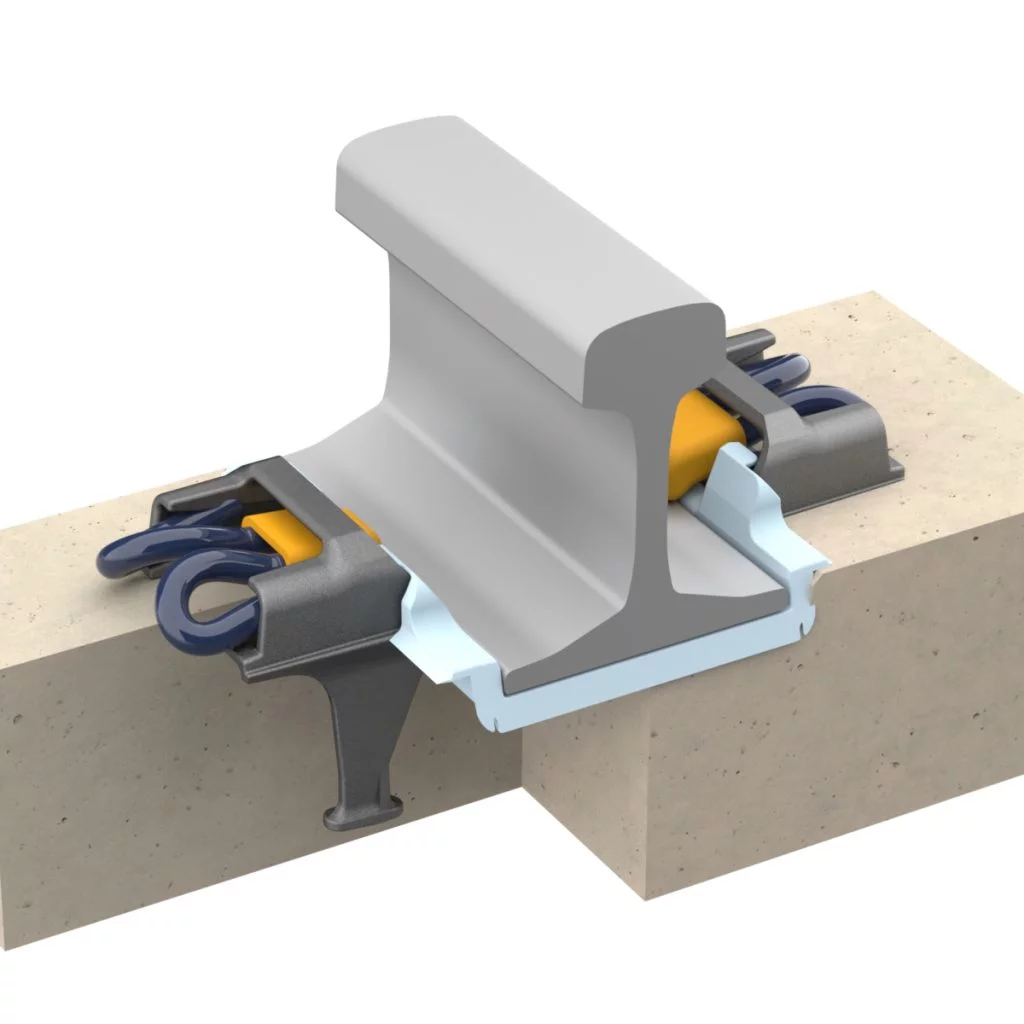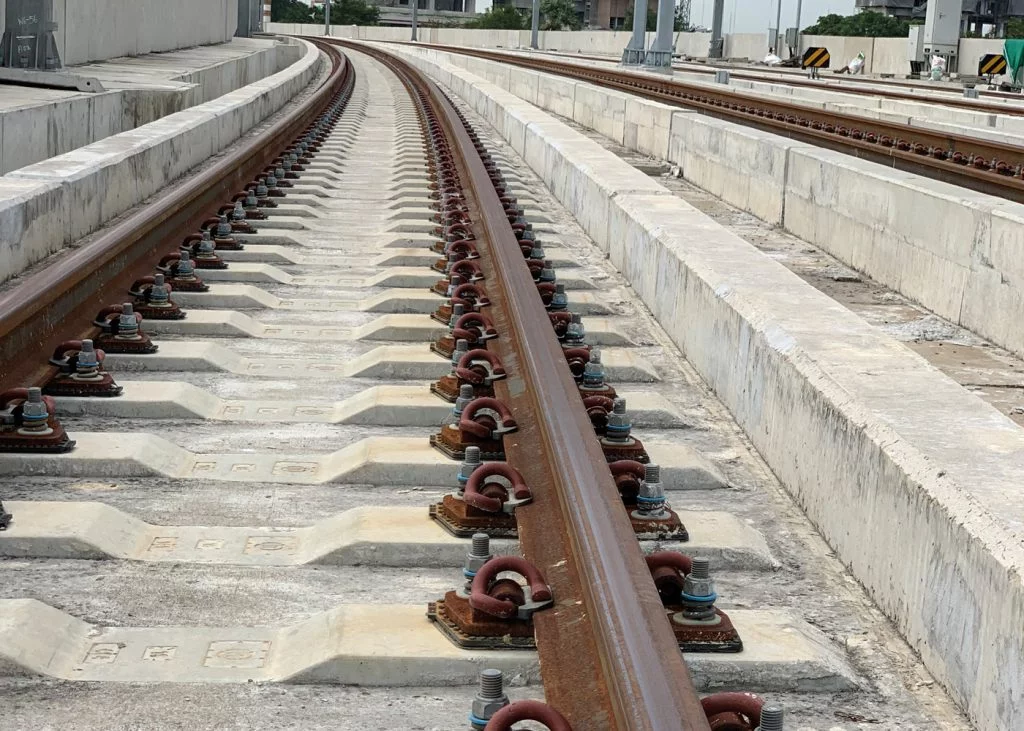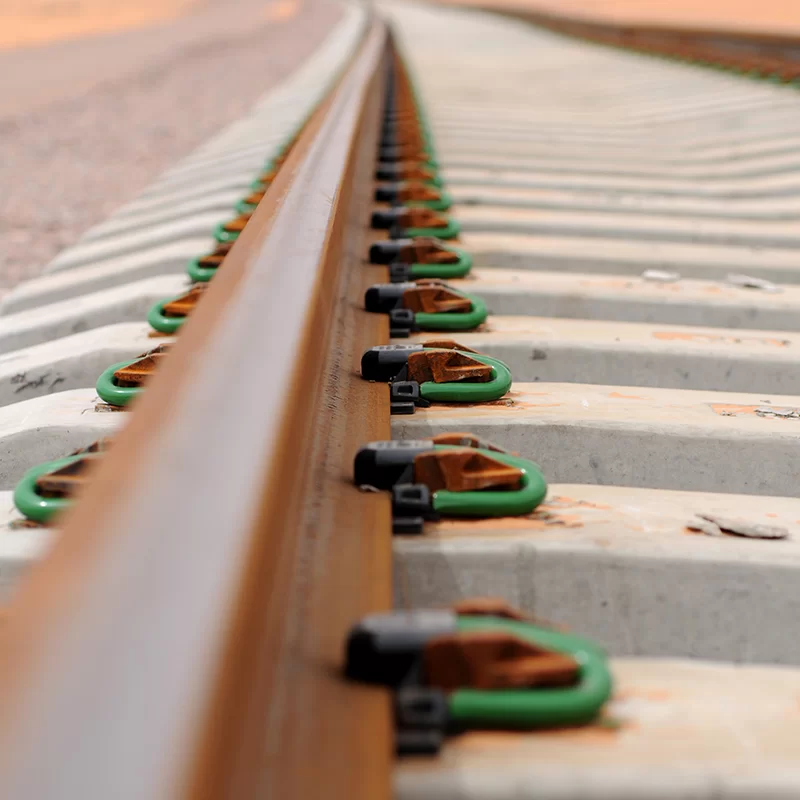Bonded Baseplates
Limit corrugation and vibration problems caused by the major dynamic forces generated by passing trains with Pandrol Bonded Baseplates. This versatile fastening solution is suitable for use on slab tracks, concrete sleepers, steel bridges, ballasted tracks, turnouts and crossings.
Pandrol Bonded Baseplates explained
The Bonded Baseplates provide both vertical and lateral stiffness via two independent cast baseplates. A one-piece bonded system (comprised of a top and bottom plate) is factory-assembled by bonding with vulcanised rubber. This provides high levels of electrical resistance, a long electrical leakage path, and lateral resilience.
This versatile system can be used on both standard track and turnouts. A single fastening system can be used for the whole track system as the standard model is designed for running track and customised models are designed for switching zones.
- Suitable for top-down and bottom-up construction
- Provides exceptional vibration mitigation
- Delivers both vertical and lateral stiffness via two independent cast baseplates
Downloads
Advantages of the Bonded Baseplates
High corrosion resistance
Protect the baseplate from atmospheric corrosion and wear thanks to the Bonded Baseplates rubber coating, which acts as the perfect protective barrier, extending the lifespan of the product.
Vibration isolation
Keep vibrations and noise generated by wheels on the track low, with the Bonded Baseplates low stiffness. This decreases the dynamic load level by distributing vibrations along the supports, rather than into the ground.
Electrical safety
Achieve a high level of stray current protection thanks to the DFF assembly’s failsafe designed, optimised to remain active and safe in situations where bond failure between rubber and metal components occurs.
Simply installation
Install the Bonded Baseplates simply and quickly. The system, or any of its components can be installed or replaced by a single person using hand tools for efficiency. Despite this ease of installation, the system provides good track elasticity and reduced rail stress.
Technical features of the ADH System (Bonded DFF)
Variable baseplate options
Choose from the Boned Baseplates two and four-hole offset and two-hole line footprint configurations to suit your application. This adaptability provides the best solutions for new build, track renewal and retrofit projects.
Variable rail fastening
Wave goodbye to worries about rail specifications – the Bonded Baseplate is available with a variety of clip types, including eClip, SD, SLK, NABLA, and FE rail fastenings to suit every specification requirement.
Electrical insulation
Achieve high levels of electrical resistance and long electrical leakage paths with the Bonded Baseplates unique bonding process. Tests against EN Standards have shown electrical insulation performance several times higher than the minimum required.
Turnout options
Choose from a variety of lengths, with different base plate lengths and options to suit all turnout applications. The Pandrol Bonded Baseplate is also suitable for steel bridges and ballasted tracks.
Track-structure interaction
Select low-toe load rail fastening clips and zero longitudinal restraint (ZLR) configurations to make the Bonded Baseplate ideal for use on bridges and viaducts. This ensures the effects of track-structure interaction are considered and mitigated appropriately.
Related products

Designed to be delivered preassembled on the sleeper or slab element, SD can deliver higher rates of construction thanks to its efficient controlled clip guidance from parked to the
in-service position.
Safe Driven (SD)

SD-E is the lightest version of the SD product family (up to 40% weight reduction).
SD-E

The system is characterized by a more compact and robust design with lower carbon footprint.
Its optimized geometry also enables automatic installation resulting improved efficiency and cost saving during installation and maintenance.
SD-RE

As its name suggests, the assembly fits on a common interface and is fully interchangeable with a range of fastenings, including FCA and DFC.
Vanguard Common Interface

As its name suggests, the fastening assembly fits on a common interface and is fully interchangeable with a range of fastenings, including FCA and Vanguard.
DFC Common Interface

The product can be pre-assembled and delivered to site captive on the pre-cast element, providing substantial cost savings.
FCA Common Interface

The SD-HH fastening system is quick and efficient to instal with few tools and minimal training.
SD-HH

The modern heavy haul railway is a demanding environment, with high locomotive horsepower, dynamic braking, large rail sections and high mega gross tonnes per year.
Victor Baseplate

Pandrol’s Fastclip FE RR rail fastening system is designed specifically for extreme heavy haul applications. It is suitable for an axle load of up to 40 tonnes and curve radius down to 150 metres.
Fastclip FE RR

The DRS baseplate is a double-resilience e-clip fastening system that is ideal for use on non-ballasted tracks when ground-borne noise and vibration reduction are required.
DRS Baseplate

Pandrol Fastclip is an established, highly-regarded resilient, threadless rail fastening. Over the years, the Fastclip family has grown to include the FC, FD, FE Fastclip products, each of which has been designed to meet the technical and commercial demands of a specific area.
Fastclip


